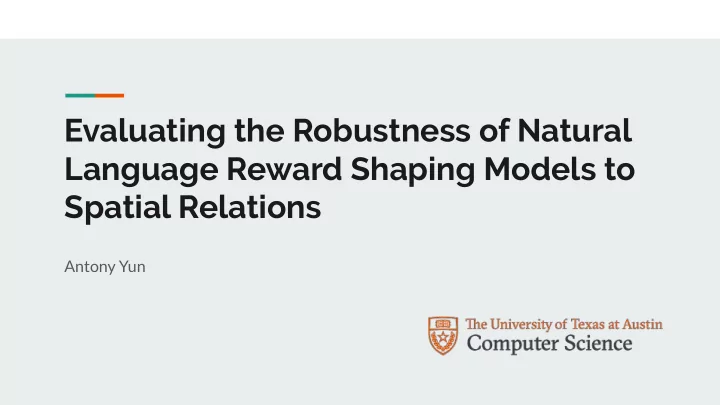

Evaluating the Robustness of Natural Language Reward Shaping Models to Spatial Relations Antony Yun
Successes of Reinforcement Learning https://deepmind.com/blog/article/alphazero-shedding-new-light-grand-games-chess-shogi-and-go https://bair.berkeley.edu/blog/2020/05/05/fabrics/ https://deepmind.com/blog/article/AlphaFold-Using-AI-for-scientific-discovery
My Work Construct a challenge dataset in the Meta-World reward shaping ● domain that contains spatially relational language Evaluate robustness of existing natural language reward shaping ● models
Outline Background on Deep Learning, Reinforcement Learning ● Natural language reward shaping ● Our Dataset ● Results ●
Background: Neural Networks Function approximators ● Trained with gradient descent ● f( ) = [0.12, 0.05, …] https://github.com/caoscott/SReC
Background: Neural Networks https://www.oreilly.com/library/view/tensorflow-for-deep/9781491980446/ch04.html https://stanford.edu/~shervine/teaching/cs-230/cheatsheet-convolutional-neural-networks https://www.researchgate.net/figure/Illustration-of-LSTM-block-s-is-the-sigmoid-function-which-play-the-role-of-gates-during_fig2_322477802
Background: Reinforcement Learning Learn a policy by interacting with the ● environment Optimize cumulative discounted reward ● https://deepmind.com/blog/article/producing-flexible-behaviours-simulated-environments http://web.stanford.edu/class/cs234/index.html
Background: Markov Decision Process (MDP) S = states ● A = actions ● T = transition function ● R = reward ● 𝛅 = discount factor ●
Background: Policy Based RL Parameterized policy ● Want optimal policy that maximizes expected reward ● Learned by gradient descent on final reward ● We use Proximal Policy Optimization (PPO) ● [Schulman et al, 2017]
Challenges with RL Sample inefficient ● https://www.alexirpan.com/2018/02/14/rl-hard.html
Challenges with RL Sample inefficient ● Good reward functions are hard to find ● Sparse: easy to design ○ https://www.alexirpan.com/2018/02/14/rl-hard.html
Challenges with RL Sample inefficient ● Good reward functions are hard to find ● Sparse: easy to design ○ Dense: easy to learn ○ https://www.alexirpan.com/2018/02/14/rl-hard.html
Background: Reward Shaping Provide additional potential reward ● Does not change the optimal policy ● [Ng et al, 1999]
Prior Work: LEARN Language-based shaping ● rewards for Montezuma's Revenge Non-experts can express intent ● 60% improvement over baseline ● "Jump over the skull while going to the left" [Goyal et al, 2019]
Prior Work: LEARN [Goyal et al, 2019]
Meta-World Object manipulation domain involving grasping, placing, and pushing ● Continuous action space, multimodal data, complex goal states ● [Yu et al, 2019]
Dense Rewards in Meta-World [Yu et al, 2019]
Dense Rewards in Meta-World [Yu et al, 2019]
Pix2R Dataset 13 Meta-World tasks, 9 objects ● 100 scenarios per task ● Videos generated using PPO on ● dense rewards 520 human-annotated descriptions ● from Amazon Mechanical Turk Use video trajectories + ● descriptions to approximate dense reward [Goyal et al, 2020]
Pix2R Architecture [Goyal et al, 2020]
Pix2R Results Adding shaping reward speeds ● up policy learning sparse rewards Sparse + Shaping rewards ● perform comparably to Dense rewards [Goyal et al, 2020]
Extending Pix2R Dataset Each scenario has only one instance of each object ● Descriptions use simplistic language ● Goal: construct a dataset containing relational language ● Probe whether model is learning multimodal semantic relationships or ● just identification Motivate development of more robust models ●
Relational Data "Turn on the coffee ● machine on the left" "Press the coffee maker ● furthest from the button"
Video Generation Target object + duplicate object + distractors ● Train PPO with dense reward until success ● 6 tasks (button_top, button_side, coffee_button, handle_press_top, ● door_lock, door_unlock) 5 scenarios per task ● 30 total scenarios ●
Collecting Natural Language Descriptions Amazon Mechanical Turk ● ‘Please ensure that the instruction you provide uniquely identifies the ● correct object, for example, by describing it with respect to other objects around it.’ At least 3 descriptions per scenario (131 total) ● Manually create negative examples ●
Evaluation Can Pix2R encode relations between objects? ● Evaluate on test split of new data ● 6 scenarios, 3 descriptions, 5 runs each → 90 runs ●
Baselines and Models Sparse: PPO with binary reward ● Dense: PPO with expert ● Meta-World reward
Baselines and Models Sparse: PPO with binary reward ● Dense: PPO with expert ● Meta-World reward Original: PPO shaped by Pix2R ● trained on original dataset
Baselines and Models Sparse: PPO with binary reward ● Dense: PPO with expert ● Meta-World reward Original: PPO shaped by Pix2R ● trained on original dataset Augmented: PPO shaped by Pix2R ● trained on combined dataset
Baselines and Models Sparse: PPO with binary reward ● Dense: PPO with expert ● Meta-World reward Original: PPO shaped by Pix2R ● trained on original dataset Augmented: PPO shaped by Pix2R ● trained on combined dataset Reduced: PPO shaped by Pix2R ● trained on original dataset, excluding relational descriptions
Results All agents perform comparably, ● except sparse Reduced even performs slightly ● better Scenarios could be too simple ● Inconclusive, further ● experimentation needed
Conclusion Pix2R is robust to our specific challenge dataset ● No immediately obvious shortcomings ● Room for further probing through challenge datasets ●
Future Work Improving our existing challenge dataset ● Refine environment generation to create more challenging ○ scenarios Multi-stage AMT pipeline for higher quality annotations ○ Other challenge datasets ● Can construct targeted, "adversarial" examples for any ML task ○
Acknowledgements Dr. Ray Mooney Prasoon Goyal
Recommend
More recommend